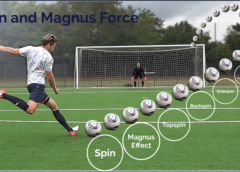Have you ever heard what is the Magnus Effect? It’s a fascinating phenomenon – a physical concept that defies gravity and is even used in sports to give athletes a competitive edge.
What is the Magnus Effect?
Simply put, the Magnus effect is a force that occurs when a rotating object, such as a ball, interacts with a substance such as air or water. This effect causes the object to experience a lifting force or a drag force, depending on the direction of rotation.
Although it may sound like something out of a science fiction movie, the Magnus effect has real-world applications, from improving the accuracy of golf shots to helping airplanes fly more efficiently.
In this article, we’ll take a look at the scientific basis of what the Magnus effect is, its history, and how it continues to shape the world around us. So fasten your seat belts and get ready to learn about a truly fascinating concept that defies the laws of gravity.
What is gravity and the evolution of its research?
Understanding the physics behind the Magnus effect
The Magnus effect is based on the force that occurs when a rotating object, such as a ball, interacts with a liquid or gas, such as air or water. This effect causes the object to experience either a lift or a drag force, depending on the direction of rotation.
The Magnus effect is based on Bernoulli’s principle, which states that when a fluid flows past an object, the fluid that moves faster creates less pressure, while the fluid that moves slower creates more pressure.
The Magnus effect is named after the German physicist Heinrich Gustav Magnus, who first described this phenomenon in 1852. Magnus discovered that when a rotating cylinder is placed in a stream of air or water, it experiences a lifting or drag force, depending on the direction of rotation. This discovery led to further research into the Magnus effect and its potential applications.
Historical context and discovery of the Magnus effect
The Magnus effect has a rich history dating back to the 19th century. In addition to Heinrich Gustav Magnus, several other scientists and engineers have contributed to our understanding of this fascinating phenomenon. One of them was the English physicist George Stokes, who first described the Magnus effect in a letter to the Royal Society in 1851.

Another key figure in the history of the Magnus effect was the German physicist Gustav Kirchhoff, who in 1877 conducted experiments with rotating cylinders. Kirchhoff’s work deepened our understanding of the Magnus effect and helped pave the way for future research in this area.
Examples of the Magnus effect in sports and everyday life
The Magnus effect has several real-world applications, from improving the accuracy of golf shots to increasing the efficiency of airplane flights.
In sports, the Magnus effect is often used by athletes to give them a competitive advantage. For example, in soccer, players can spin the ball so that it curves in the air, making it harder for the goalkeeper to predict its trajectory. Similarly, in baseball, pitchers can use the Magnus effect to make the pitch curve or fall unexpectedly.
But the Magnus effect is not limited to sports. It also has applications in everyday life.
For example, the design of wind turbines is based on the Magnus effect, as the rotating turbine blades create a lift that is then converted into electricity.
The Magnus effect is also used in the design of propellers used to move boats and submarines through the water.
Applications of the Magnus effect in technology and engineering
The Magnus effect is widely used in technology and engineering. In addition to wind turbines and propellers, the Magnus effect is used in aircraft construction. For example, airplane wings are designed to generate lift, which is based on the same principles as the Magnus effect. By designing the wings in such a way that they generate the right amount of lift, engineers can create airplanes that use less fuel and can fly farther.
The Magnus effect is also used in the design of racing cars, where it is used to create a downward force that helps keep the car moving at high speeds. This downward force is created by air passing over the car body, which is shaped to create a low-pressure zone that pulls the car to the ground.
Future potential of the Magnus effect in renewable energy
As the world looks for ways to reduce its dependence on fossil fuels, the Magnus effect is becoming increasingly important in the renewable energy industry. The Magnus effect is already being used in wind turbines, but researchers are also exploring other ways to harness the phenomenon. For example, some researchers are exploring the possibility of using rotating spheres to generate electricity using the Magnus effect.

In addition, the Magnus effect can be used to develop new types of aircraft powered by renewable energy sources, such as solar energy. By using the Magnus effect to generate lift, these aircraft could fly longer without the need for fuel.
Exploring misconceptions and common myths about the Magnus effect
Despite its widespread use and fascinating properties, there are several misconceptions and myths surrounding the Magnus effect. One of the most common myths is that the Magnus effect is caused only by the rotation of an object. In fact, the Magnus effect is also influenced by the speed and direction of the fluid, as well as the shape and size of the object.
Another common misconception is that the Magnus effect can only be applied to round objects such as spheres. While it is true that the Magnus effect is most commonly observed in round objects, it can also occur in objects with other shapes, such as cylinders or blades.
Conducting experiments and testing the Magnus effect
If you are interested in learning more about the Magnus effect, you can conduct your own experiments to observe this phenomenon in action. One simple experiment is to spin a ping-pong ball in a stream of air. As the ball rotates, it is subjected to a pushing force that causes it to rise into the air.
Another experiment involves rotating a cylinder in a stream of water. As the cylinder rotates, it is subjected to a drag force that causes it to move in the opposite direction of rotation.
Innovations and inventions inspired by the Magnus effect
The Magnus effect has inspired several innovations and inventions over the years. One of the most prominent examples is the Magnus effect sail, a type of sail that uses the Magnus effect to generate lift and propel a boat forward. The Magnus effect sail was first used in the 1920s by German sailor Anton Flettner, and it is still used on some sailboats today.

| Photo:https://www.shippingwondersoftheworld.com/rotor-ships.html
Another example of an invention inspired by the Magnus effect is the Magnus fan, a type of fan that uses the Magnus effect to move air. The Magnus effect fan was first developed in the 1930s by German engineer Albert Betz, and it is still in use in some industrial sectors.
Conclusions and final thoughts
The Magnus effect is a fascinating phenomenon that has been studied for centuries. Its applications range from sports to renewable energy, technology, and engineering. Although there are still many mysteries surrounding the Magnus effect, we have made significant progress in understanding the phenomenon in recent years.
As we continue to explore what the Magnus effect is and the potential of the Magnus effect, we are confident that we will find exciting new applications for this amazing force that defies gravity.



